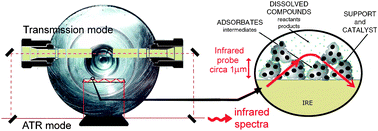In situ attenuated total reflection Fourier transform infrared (ATR-FT-IR) spectroscopy has gained considerable attention as a powerful tool for exploring processes occurring at solid/liquid and solid/liquid/gas interfaces as encountered in heterogeneous catalysis and electrochemistry. Understanding of the molecular interactions occurring at the surface of a catalyst is not only of fundamental interest but constitutes the basis for a rational design of heterogeneous catalytic systems. Infrared spectroscopy has the exceptional advantage to provide information about structure and environment of molecules. In the last decade, in situ ATR-FT-IR has been developed rapidly and successfully applied for unraveling processes occurring at solid/liquid interfaces. Additionally, the kinetics of complex reactions can be followed by quantifying the concentration of products and reactants simultaneously in a non-destructive way. In this tutorial review we discuss some key aspects which have to be taken into account for successful application of in situ ATR-FT-IR to examine solid/liquid catalytic interfaces, including different experimental aspects concerned with the internal reflection element, catalyst deposition, cell design, and advanced experimental methods and spectrum analysis. Some of these aspects are illustrated using recent examples from our research. Finally, the potential and some limitations of ATR will be elucidated.

You have access to this article
 Please wait while we load your content...
Something went wrong. Try again?
Please wait while we load your content...
Something went wrong. Try again?


 Please wait while we load your content...
Please wait while we load your content...